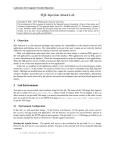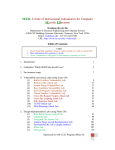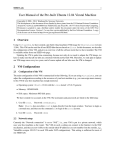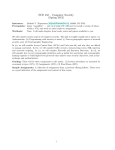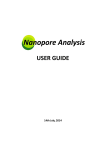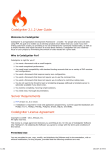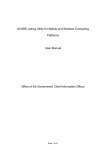Download SQL Injection Attack Lab – Using Collabtive
Transcript
Laboratory for Computer Security Education
1
SQL Injection Attack Lab – Using Collabtive
(Web Application: Collabtive)
c 2006 - 2011 Wenliang Du, Syracuse University.
Copyright The development of this document is/was funded by three grants from the US National Science Foundation:
Awards No. 0231122 and 0618680 from TUES/CCLI and Award No. 1017771 from Trustworthy Computing.
Permission is granted to copy, distribute and/or modify this document under the terms of the GNU Free
Documentation License, Version 1.2 or any later version published by the Free Software Foundation. A copy
of the license can be found at http://www.gnu.org/licenses/fdl.html.
1
Overview
SQL injection is a code injection technique that exploits the vulnerabilities in the interface between web
applications and database servers. The vulnerability is present when user’s inputs are not correctly checked
within the web applications before sending to the back-end database servers.
Many web applications take inputs from users, and then use these inputs to construct SQL queries, so
the web applications can pull the information out of the database. Web applications also use SQL queries
to store information in the database. These are common practices in the development of web applications.
When the SQL queries are not carefully constructed, SQL-injection vulnerabilities can occur. SQL-injection
attacks is one of the most frequent attacks on web applications.
In this lab, we modified a web application called Collabtive, and disabled several countermeasures
implemented by Collabtive. As the results, we created a version of Collabtive that is vulnerable
to the SQL-Injection attack. Although our modifications are artificial, they capture the common mistakes
made by many web developers. Students’ goal in this lab is to find ways to exploit the SQL-Injection
vulnerabilities, demonstrate the damage that can be achieved by the attacks, and master the techniques that
can help defend against such attacks.
2
Lab Environment
You need to use our provided virtual machine image for this lab. The name of the VM image that supports
this lab is called SEEDUbuntu11.04-Aug-2011, which is built in August 2011. If you happen to have
an older version of our pre-built VM image, you need to download the most recent version, as the older
version does not work for this lab. Go to our SEED web page (http://www.cis.syr.edu/˜wedu/
seed/) to get the VM image.
2.1
Environment Configuration
You need to use our provided virtual machine image for this lab. The name of the VM image that supports
this lab is called SEEDUbuntu11.04-Aug-2011, which is built in August 2011. If you happen to have
an older version of our pre-built VM image, you need to download the most recent version, as the older
version does not support this lab. Go to our SEED web page (http://www.cis.syr.edu/˜wedu/
seed/) to get the VM image.
Laboratory for Computer Security Education
2.2
2
Environment Configuration
In this lab, we need three things, are of which are already installed in the provided VM image: (1) the
Firefox web browser, (2) the Apache web server, and (3) the Collabtive project management web application. For the browser, we need to use the LiveHTTPHeaders extension for Firefox to inspect the
HTTP requests and responses. The pre-built Ubuntu VM image provided to you has already installed the
Firefox web browser with the required extensions.
Starting the Apache Server. The Apache web server is also included in the pre-built Ubuntu image.
However, the web server is not started by default. You need to first start the web server using the following
command:
% sudo service apache2 start
The Collabtive Web Application. We use an open-source web application called Collabtive in
this lab. Collabtive is a web-based project management system. This web application is already set
up in the pre-built Ubuntu VM image. We have also created several user accounts on the Collabtive
server. To see all the users’ account information, first log in as the admin using the following password;
other users’ account information can be obtained from the post on the front page.
username: admin
password: admin
Configuring DNS. We have configured the following URL needed for this lab. To access the URL , the
Apache server needs to be started first:
URL
http://www.sqllabcollabtive.com
Description
Collabtive
Directory
/var/www/SQL/Collabtive/
The above URL is only accessible from inside of the virtual machine, because we have modified
the /etc/hosts file to map the domain name of each URL to the virtual machine’s local IP address
(127.0.0.1). You may map any domain name to a particular IP address using /etc/hosts. For example you can map http://www.example.com to the local IP address by appending the following entry
to /etc/hosts:
127.0.0.1
www.example.com
If your web server and browser are running on two different machines, you need to modify /etc/hosts
on the browser’s machine accordingly to map these domain names to the web server’s IP address, not to
127.0.0.1.
Configuring Apache Server. In the pre-built VM image, we use Apache server to host all the web sites
used in the lab. The name-based virtual hosting feature in Apache could be used to host several web sites (or
URLs) on the same machine. A configuration file named default in the directory "/etc/apache2/
sites-available" contains the necessary directives for the configuration:
1. The directive "NameVirtualHost *" instructs the web server to use all IP addresses in the machine (some machines may have multiple IP addresses).
Laboratory for Computer Security Education
3
2. Each web site has a VirtualHost block that specifies the URL for the web site and directory
in the file system that contains the sources for the web site. For example, to configure a web site
with URL http://www.example1.com with sources in directory /var/www/Example_1/,
and to configure a web site with URL http://www.example2.com with sources in directory
/var/www/Example_2/, we use the following blocks:
<VirtualHost *>
ServerName http://www.example1.com
DocumentRoot /var/www/Example_1/
</VirtualHost>
<VirtualHost *>
ServerName http://www.example2.com
DocumentRoot /var/www/Example_2/
</VirtualHost>
You may modify the web application by accessing the source in the mentioned directories. For example,
with the above configuration, the web application http://www.example1.com can be changed by
modifying the sources in the directory /var/www/Example_1/.
2.3
Turn Off the Countermeasure
PHP provides a mechanism to automatically defend against SQL injection attacks. The method is called
magic quote, and more details will be introduced in Task 3. Let us turn off this protection first (this protection
method is deprecated after PHP version 5.3.0).
1. Go to /etc/php5/apache2/php.ini.
2. Find the line: magic quotes gpc = On.
3. Change it to this: magic quotes gpc = Off.
4. Restart the Apache server by running "sudo service apache2 restart".
2.4
Note for Instructors
If the instructor plans to hold lab sessions for this lab, we suggest that the following background materials
be covered in the lab sessions:
1. How to use the virtual machine, Firefox web browser, the LiveHTTPHeaders and Tamper Data
add-ons.
2. Brief introduction to SQL: only needs to cover the basic structure of the SELECT, UPDATE, and
INSERT statements. A useful online SQL tutorial can be found at http://www.w3schools.
com/sql/.
3. How to operate the MySQL database (only the basics). The account information about the MySQL
database can be found in the ”User Manual of the Pre-built Ubuntu 9 Virtual Machine”, which can be
downloaded from our SEED web page.
4. Brief introduction to PHP: only needs to cover the very basics. Students who have a background in
C/C++, Java, or other language should be able to pick up this script language quite quickly.
Laboratory for Computer Security Education
3
3.1
4
Lab Tasks
Task 1: SQL Injection Attack on SELECT Statements
In this task, you need to manage to log into Collabtive at www.sqllabcollabtive.com, without providing a password. You can achieve this using SQL injections. Normally, before users start using
Collabtive, they need to login using their user names and passwords. Collabtive displays a login
window to users and ask them to input username and password. The login window is displayed in the
following:
The authentication is implemented by include/class.user.php in the Collabtive root directory
(i.e., /var/www/SQL/Collabtive/). It uses the user-provided data to find out whether they match
with the username and user password fields of any record in the database. If there is a match, it
means the user has provided a correct username and password combination, and should be allowed to login.
Like most web applications, PHP programs interact with their back-end databases using the standard SQL
language. In Collabtive, the following SQL query is constructed in class.user.php to authenticate
users:
$sel1 = mysql_query ("SELECT ID, name, locale, lastlogin, gender,
FROM USERS_TABLE
WHERE (name = ’$user’ OR email = ’$user’) AND pass = ’$pass’");
$chk = mysql_fetch_array($sel1);
if (found one record)
then {allow the user to login}
In the above SQL statement, the USERS TABLE is a macro in PHP, and will be replaced by the users
table named user. The variable $user holds the string typed in the Username textbox, and $pass
holds the string typed in the Password textbox. User’s inputs in these two textboxs are placed directly in
the SQL query string.
Laboratory for Computer Security Education
5
SQL Injection Attacks on Login: There is a SQL-injection vulnerability in the above query. Can you
take advantage of this vulnerability to achieve the following objectives?
• Task 1.1: Can you log into another person’s account without knowing the correct password?
• Task 1.2: Can you find a way to modify the database (still using the above SQL query)? For example,
can you add a new account to the database, or delete an existing user account? Obviously, the above
SQL statement is a query-only statement, and cannot update the database. However, using SQL
injection, you can turn the above statement into two statements, with the second one being the update
statement. Please try this method, and see whether you can successfully update the database.
To be honest, we are unable to achieve the update goal. This is because of a particular defense
mechanism implemented in MySQL. In the report, you should show us what you have tried in order
to modify the database. You should find out why the attack fails, what mechanism in MySQL has
prevented such an attack. You may look up evidences (second-hand) from the Internet to support your
conclusion. However, a first-hand evidence will get more points (use your own creativity to find out
first-hand evidences). If in case you find ways to succeed in the attacks, you will be awarded bonus
points.
3.2
Task 2: SQL Injection on UPDATE Statements
In this task, you need to make an unauthorized modification to the database. Your goal is to modify another
user’s profile using SQL injections. In Collabtive, if users want to update their profiles, they can go to
My account, click the Edit link, and then fill out a form to update the profile information. After the
user sends the update request to the server, an UPDATE SQL statement will be constructed in include/
class.user.php. The objective of this statement is to modify the current user’s profile information in
the users table. There is a SQL injection vulnerability in this SQL statement. Please find the vulnerability,
and then use it to do the following:
• Change another user’s profile without knowing his/her password. For example, if you are logged in
as Alice, your goal is to use the vulnerability to modify Ted’s profile information, including Ted’s
password. After the attack, you should be able to log into Ted’s account.
3.3
Task 3: Countermeasures
The fundamental problem of SQL injection vulnerability is the failure of separating code from data. When
constructing a SQL statement, the program (e.g. PHP program) knows what part is data and what part is
code. Unfortunately, when the SQL statement is sent to the database, the boundary has disappeared; the
boundaries that the SQL interpreter sees may be different from the original boundaries, if code are injected
into the data field. To solve this problem, it is important to ensure that the view of the boundaries are
consistent in the server-side code and in the database. There are various ways to achieve this: this objective.
• Task 3.1: Escaping Special Characters using magic quotes gpc. In the PHP code, if a data
variable is the string type, it needs to be enclosed within a pair of single quote symbols (’). For example, in the SQL query listed above, we see name = ’$user’. The single quote symbol surrounding
$user basically “tries” to separate the data in the $user variable from the code. Unfortunately, this
separation will fail if the contents of $user include any single quote. Therefore, we need a mechanism to tell the database that a single quote in $user should be treated as part of the data, not as a
special character in SQL. All we need to do is to add a backslash (\) before the single quote.
Laboratory for Computer Security Education
6
PHP provides a mechanism to automatically add a backslash before single-quote (’), double quote
("), backslash (\), and NULL characters. If this option is turned on, all these characters in the inputs
from the users will be automatically escaped. To turn on this option, go to /etc/php5/apache2/
php.ini, and add magic quotes gpc = On (the option is already on in the VM provided to
you). Remember, if you update php.ini, you need to restart the Apache server by running "sudo
service apache2 restart"; otherwise, your change will not take effect.
Please turn on/off the magic quote mechanism, and see how it help the protection. Please be noted that
starting from PHP 5.3.0 (the version in our provided VM is 5.3.5), the feature has been DEPRECATE1 ,
due to several reasons:
– Portability: Assuming it to be on, or off, affects portability. Most code has to use a function
called get magic quotes gpc() to check for this, and code accordingly.
– Performance and Inconvenience: not all user inputs are used for SQL queries, so mandatory
escaping all data not only affects performance, but also become annoying when some data are
not supposed to be escaped.
• Task 3.2: Escaping Special Characters using mysql real escape string. A better way to
escape data to defend against SQL injection is to use database specific escaping mechanisms, instead of relying upon features like magical quotes. MySQL provides an escaping mechanism, called
mysql real escape string(), which prepends backslashes to a few special characters, including \x00, \n, \r, \, ’, " and \x1A. Please use this function to fix the SQL injection vulnerabilities identified in the previous tasks. You should disable the other protection schemes described in
the previous tasks before working on this task.
• Task 3.3: Prepare Statement. A more general solution to separating data from SQL logic is to tell
the database exactly which part is the data part and which part is the logic part. MySQL provides the
prepare statement mechanism for this purpose.
$db = new mysqli("localhost", "user", "pass", "db");
$stmt = $db->prepare("SELECT ID, name, locale, lastlogin FROM users
WHERE name=? AND age=?");
$stmt->bind_param("si", $user, $age);
$stmt->execute();
//The following two functions are only useful for SELECT statements
$stmt->bind_result($bind_ID, $bind_name, $bind_locale, $bind_lastlogin);
$chk=$stmt->fetch();
Parameters for the new mysqli() function can be found in /config/standard/config.php.
Using the prepare statement mechanism, we divide the process of sending a SQL statement to the
database into two steps. The first step is to send the code, i.e., the SQL statement without the data
that need to be plugged in later. This is the prepare step. After this step, we then send the data to the
database using bind param(). The database will treat everything sent in this step only as data, not
1
In the process of authoring computer software, its standards or documentation, deprecation is a status applied to software
features to indicate that they should be avoided, typically because they have been superseded. Although deprecated features remain
in the software, their use may raise warning messages recommending alternative practices, and deprecation may indicate that the
feature will be removed in the future. Feature are deprecated- rather than immediately removed-in order to provide backward
compatibility, and give programmers who have used the feature time to bring their code into compliance with the new standard.
Laboratory for Computer Security Education
7
as code anymore. If it’s a SELECT statement, we need to bind variables to a prepared statement for
result storage, and then fetch the results into the bound variables.
Please use the prepare statement mechanism to fix the SQL injection vulnerability in the Collabtive
code. In the bind param function, the first argument "si" means that the first parameter ($user)
has a string type, and the second parameter ($age) has an integer type.
4
Guidelines
Print out debugging information. When we debug traditional programs (e.g. C programs) without using
any debugging tool, we often use printf() to print out some debugging information. In web applications,
whatever are printed out by the server-side program is actually displayed in the web page sent to the users;
the debugging printout may mess up with the web page. There are several ways to solve this problem. A
simple way is to print out all the information to a file. For example, the following code snippet can be used
by the server-side PHP program to print out the value of a variable to a file.
$myFile = "/tmp/mylog.txt";
$fh = fopen($myFile, ’a’) or die("can’t open file");
$Data = "a string";
fwrite($fh, $Data . "\n");
fclose($fh);
A useful Firefox Add-on. Firefox has an add-on called "Tamper Data", it allows you to modify each
field in the HTTP request before the request is sent to the server. For example, after clicking a button on a
web page, an HTTP request will be generated. However, before it is sent out, the "Tamper Data" add-on
intercepts the request, and gives you a chance to make an arbitrary change on the request. This tool is quite
handy in this lab.
The add-on only works for Firefox versions 3.5 and above. If your Firefox has an earlier version, you
need to upgrade it for this add-on. In our most recently built virtual machine image (SEEDUbuntu11.04Aug-2011), Firefox is already upgraded to version 5.0, and the "Tamper Data" add-on is already installed.
5
Submission
You need to submit a detailed lab report to describe what you have done and what you have observed. Please
provide details using LiveHTTPHeaders, Wireshark, and/or screen shots. You also need to provide
explanation to the observations that are interesting or surprising.







